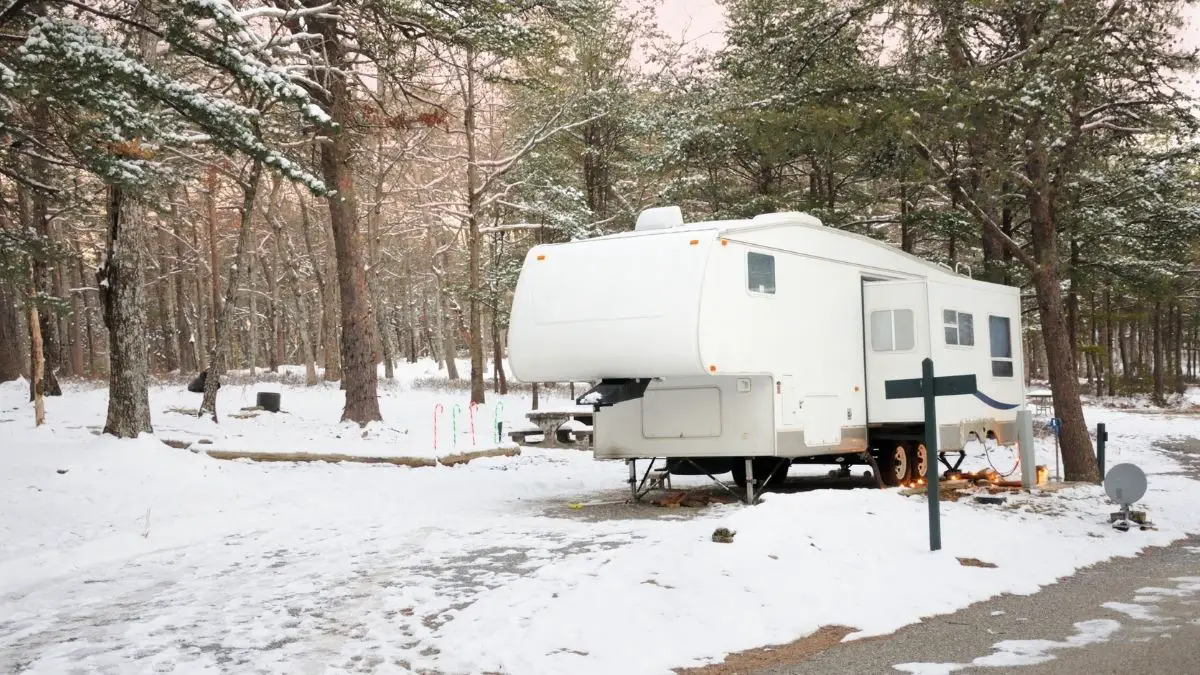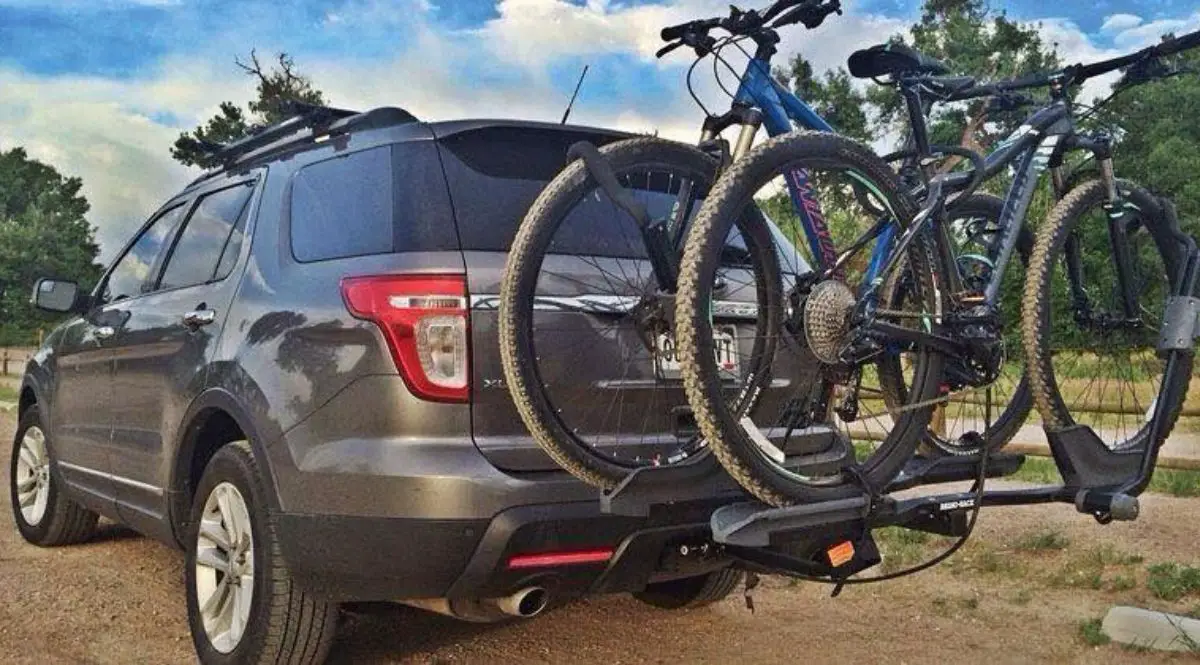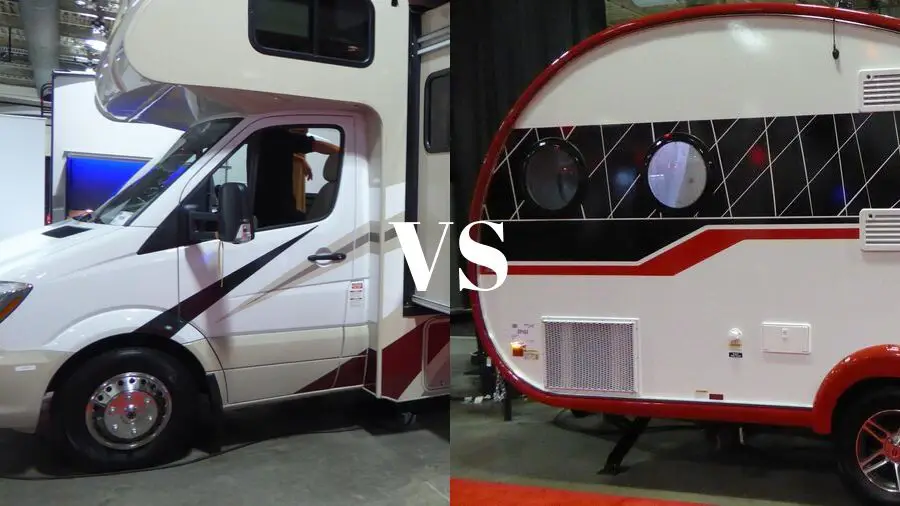Some people love winter, while others aren’t too fond of it, while others who have downsized to living in their RV fulltime will live in their RV and choose to stay somewhere where it might get a little cold in the winter. Whichever the case, I’ve collated what could be the ultimate RV winter survival for living in or camping in your RV through winter.
We’ll go in depth on the preparations needed for your RV, and a lot of tips and tricks to keep your rig liveable, so you can make the most of the winter months in your RV. For those who love the snow and camping in the winter, or you’re living in your RV long-term, it’s very important to make sure your RV is liveable and protected during this time of the year. Once you’ve settled in, you can focus on all the fun your winter activities can bring (skiing, snowboarding, etc.) or just snuggling in while looking out your RV window. You will want to know when it is maybe too cold to stay in your RV and you might consider alternate plans or prepare for the worst and get through it in you Rig. There are many people who do this even in Alaska or northern Alberta, Canada.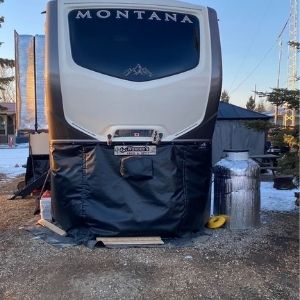
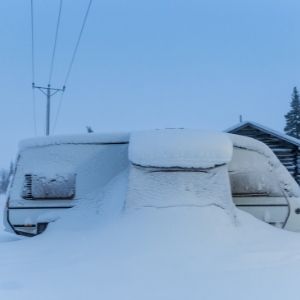
How Cold Does It Have To Be For RV Tanks & Pipes to Freeze?
It will take the ambient temperature to dip below 32°F /0°C for relatively 24 hours for RV pipes and tanks to freeze. But note that this is dependent on multiple factors like if your rig and pipes are insulated or how protected your RV’s underbelly is with a skirt to keep the cold winds from robbing the heat from underneath.
Is It Possible To Live In An RV All Winter Long?
You can live in your RV during winter. Just must make sure that you have the necessities you need to survive, depending on how cold it gets where you are, but the colder it is, the more likely you will need electricity, additional insulation, and a skirt, to keep things warm in your RV. If you are planning on boondocking, I would consider going somewhere further south or south west such as northern California, Nevada, Arizonia, New Mexico, Oklahoma, etc where the temperatures more temperate and tolerable. Depending on how long you plan to live in the RV (taking into consideration if you’re living in one long-term), the organization of it and the preparation needed will need to be planned well.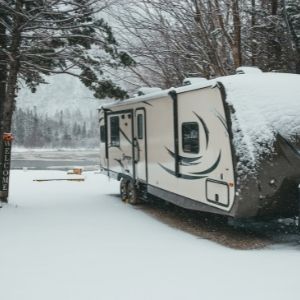
How Do I Make My Camper Warm In Winter?
There are several things that can be done to keep your RV from freezing in the winter is you are planning to stay in it for the duration of winter. The number one item that needs to be done is to keep the belly of your Rig dropping below 32°F /0°C. This can be achieved by doing following things: Put an insulated skirt around the bottom of your RV that seals the wind from taking away any heat from underneath your rig. Stay somewhere where you have full service, (water, electricity & sewer) for your whole stay through winter. Add a small electric heater underneath your RV in the sealed space of your skirt. Keep the temperature inside your RV at a cozy temperature (above 69°F /21°C) by running the furnace, having space heaters. Get a 200-gallon propane tank so you don’t run out of propane in the middle of a cold spell. Some people use buddy heaters, but I would not recommend them as they can produce Carbon monoxide, you can read about it here.- Add additional insulation to the windows with the reflective bubble foil.
- Add extra layers of curtains to the inside windows.
- Add extra layer of Styrofoam insulation to the inside walls if you need to
- Any sliders will need extra layers of insulation to the slides sidewalls.
- Seal overhead vents with insulation pillows.
- Use heated water intake hoses to keep the water flowing into your unit.
- Keep the door closed as much as possible.
- Do not remove the thick layer of snow built up on top and around your RV, it works as insulation when it is cold.
- Add an electrically heated water hose.
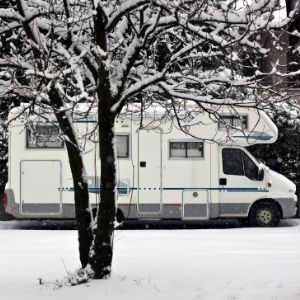
How Do I Get My RV Ready For Winter Camping?
Starting from the basics, to boondocking during winter, I’ve compiled all the best practices I do, and all the others I could find from other experienced #RVers who love to camp in cold temperatures. I’ve sectioned the answer to this question into three parts as there are quite a few things that need to be completed to be ready for Winter:- Planning For A Winter Stay In Your RV
- External RV Preparations
- Internal RV Preparations
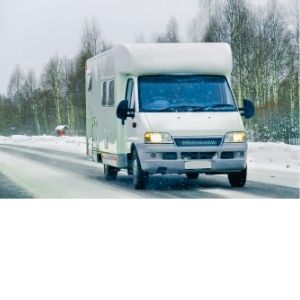
Planning For A Winter Stay In Your RV
Before winter even begins, you’ll need to plan ahead of time the location where you’ll be spending winter and what you plan to do. As well as what kinds of temperatures that you might experience and how much snow you might get each year. Is this year expected to be typical, extreme, or mild? I’m sure you’ll want to bring any winter toys with you (skis, snowmobile, etc.) or park your RV near a winter recreational area or lodge. Especially if you’re boondocking, and living in your RV long-term, you’ll want to stay some where the daily temperatures are tolerable without continuous electricity. With your location picked It’s time to get your RV ready.External RV Preparations For Winter Camping
The list below is broken down by parts to hopefully make sure you prepare every part of your RV before the temperature drops. The is because you’d definitely want enough time for any sealant to dry properly and/or allow enough time for anything you order online to get to you before it’s too late. Leveling Jacks/Tires You found the perfect place to park your Rig for the winter season, and now you have to make sure it all snuggly stays there. To help secure them in place you can: Install RV SnapPads on all leveling jack pads, preferably in temperatures above 55°F (13°C). These add more circumference in each jack pad’s footprint. They also help ensure your RV doesn’t sink into the ground with the changing temperature or when the ice/snow thaws or damage parking surfaces. Plus, it also prevents your RV slipping in high winds or slick surfaces, dampens vibration and conforms on uneven terrain (gravel, etc.). Using leveling blocks under your RV/motorhome/trailer’s leveling jacks and your trailer’s hitch pad can help keep them from sinking if ever the ground gets soft (from the melting and thawing of the snow) or on uneven terrain. RV Basement/Underbelly: To keep pipes from freezing and your RV floors evenly warm, you can use an easy snap RV skirt once you’ve properly settled in your trailer on the camping ground. You might want to invest in a custom skirt, if you plan on this kind of living for the long term. Using foam insulation R-value sheets can add an extra layer of protection if you think your RV needs to retain more heat, especially if you know the temperatures will drop more during the season (plus, you can also use the foam sheets on your windows inside the cabin area).
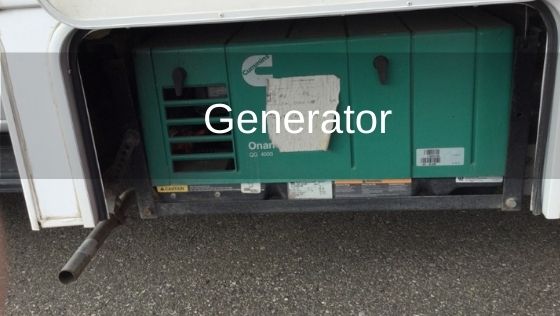

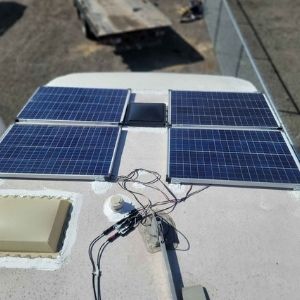
Internal RV Preparations For Winter Camping
Wall insulation. Depending on the trailer/camper or RV that you have, your budget and the time you have, and you plan to really invest in the proper insulation, you can have the walls of your unit insulated with extra panels of foam insulation. Safety devices (carbon monoxide detectors, smoke detectors and fire alarms): Any safety device, especially those which are battery operated, always need to be inspected at least annually. Because batteries work better at a certain temperature range, it would be good to always make sure you know when they were last replaced (some suggest every six (6) months) and be weary of the ambient temperature inside the cabin. Always check the manufacturer’s maintenance instructions. Fire extinguishers. Depending where you are in the world, the safety regulations for RV will differ, so please make sure to check what’s required in the area you’re camping in. If you’re not familiar with fire extinguishers per se, there are many different types depending on how the fire started (electrical, oil, combustibles, etc.), so make sure the one you have CAN be used for both combustibles (paper, wood, etc.) and electrical equipment. I mention this because the chemical used in some fire extinguishers are corrosive and can damage electrical equipment. Depending on the fire extinguisher type, it will require some maintenance, so best check on what you have and check the fire extinguishers at least once a month. Ceiling Fans and Skylights. Closing the ceiling vents with either a DIY-insulation panel or a pre-made RV vent and skylight insulation cover will prevent heat loss. If there isn’t an option to seal them, it may be good to replace them with manual two-way closable AC vents. If the heat is uneven in the cabin area, using the ceiling fan can help circulate and even out the temperature. Most ceiling fans have two (2) directions – clockwise (which pushes the air UP) and counter-clockwise (which pushes the air DOWN). Because warm air rises, you’d like to make the air go down so it keeps the temperature a bit more constant (on the lowest setting), and it would save your heater from working too hard. AC Units. Depending on the type of RV air conditioning unit you have, it would be good to seal this off with a cover or shroud (whichever is available) to prevent cold drafts from entering your RV and so you don’t lose all that precious heat inside the camper. If you’re still feeling a draft from the AC unit, you can also either make a DIY insulated vent cover or find one that your current RV vent brand may already have (e.g. like this vent cover for a Camco vent). Windows/Doors: You lose a lot of heat through RV windows merely because they’re not as insulated as the rest of the cabin area. Inspect for cracks, gaps and seals and use a flexible sealant while it’s warm outside so that the caulk can adhere firmly. Keep doors/windows shut, and only open them when needed. Do remember to crack open a window if using propane space heaters. Check the weather stripping as well and make sure it’s not damaged, because if so, do replace it. You can also use reflective insulation for windows since it’ll serve as insulation due to its two-layers of insulating bubbles. Pulling down the window shades also acts as another window insulation. You can keep it closed unless using propane space heaters. Adding heavy-weight thermal curtains which definitely comes in different lengths and colours you can customise to your needs. Of course, you’ll have the option to choose whether you want to actually do laundry in your RV during this season because you may just be using your RV for a just a few days or a week (or two). If you’re living in your RV long-term, hand-washing a LOT of items won’t really work unless we’re just talking about undergarments (not beddings and coats, etc.). Laundromats nearby can be a good option, but if you’re boondocking long-term getting a washer/dryer combo might be better (especially knowing you can’t hang a lot of things inside your RV to dry). Batteries. Battery maintenance will really depend on the type of RV batteries you have. I wrote a lot about it in detail in the article HERE. As a quick summary, some batteries work better at lower temperatures (check the ones with higher CCA markings), while others don’t. You can also use a 40-60W incandescent utility light to keep the space above freezing, or try a silicone heater pad. Special attention needs to be given if you have: Lead-acid battery: A discharged lead-acid battery is prone to freezing and may need more care (maintenance, block heater, etc.) for it to work at lower temperatures. Refrigerator For the refrigerator, you might want to inspect the venting, heating elements as well as the pilot lights to make sure that your fridge is working fine and ready for winter. Space heating: There are many ways of heating your RV. Whether you’re using a portable gas heater (designed while boondocking), your RV has its own heater or furnace, or using portable electric heaters, there are options available to suit your needs.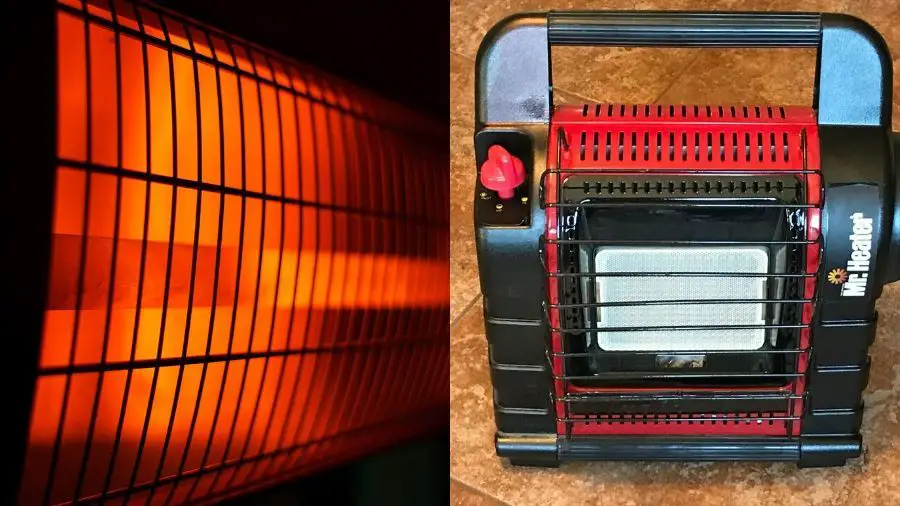
RV Winter Packing: What to Pack for a Winter RV Trip?
Packing for winter may come naturally for some, but maybe not so much for others. I wanted this section to serve like a check list to make sure you have all the right stuff with you ready when you need it. Whether you’re boondocking for a week (or two), or staying in one spot for the whole season, it’s always good to have the following: Thermometer(s). Your RV should have quite a few in each of the compartments (the cabin, the basement where the water tanks are, where the batteries are stored, the engine (unless you already have a engine heater with a thermostat there), in the fridge, etc.). Backup supplies (food, water, fuel, batteries &/or at least knowing where to get any supplies, medicines, etc.) Emergency kit (for RV repairs, waterproofing, insulation options, a first aid kit, etc. ) Clothing for weather that’s colder than expected and extra layers: As a friend of mine always says, there’s no such thing as bad weather, just bad clothing. This is very true when it comes to winter clothing. In essence, always make sure to have the fundamental three layers – base, middle & outer layers. I won’t go into detail too much about the middle and outer winter layers, but what I found really essential is some things that are very important when it comes to the base layer: Having a base layer that’s breathable, wicks moisture away, and provides warmth is as essential as having a proper outer layer. Always look into the product details since they can explain how much moisture it can wick away while keeping you warm because not all long johns are created equal. Take for example base layer designed for high performance activities (snowboarding, skiing, etc.) – made with merino wool , versus one that isn’t a low perspiration wicking, slightly breathable and uses cationic polyester. This is something you wouldn’t want to go cheap on because you’ll feel the difference once the temperature starts dropping. Socks. You can always layer your socks, but make sure they wick moisture away from your skin and dry fast as well. Underwear. It doesn’t have to be anything special since the base layer should be enough. I personally recommend though to use undergarments that also wick moisture away from skin, lightweight AND dries really fast even if you just handwash your undergarments (can you imagine the laundry you’ll need to do especially if living in a confined space). Remember that it’s not really about the brand, but the technology that comes with the garment. Not all fabrics are created equal, so even if you have a tight budget, there will always be something that fits your budget. Other miscellaneous items that add warmth: From fuzzy slippers, to adult onesies and fluffy floor coverings or rugs. You can get a lot of ideas on how to make sure that there will be something that can retain YOUR body heat and the heat in your camper. Pet Clothing: Getting a winter coat or winter booties for your pet will totally depend on the animal and the weather. I’m putting it here just as a reminder since we’re on the topic of packing.How To Stay Warm In Your RV During Those Really Cold Nights
To stay warm in your RV during those REALLY cold nights will need an orchestra of not just your preparing your RV (see previous sections), but making sure you have a backup heat source or insulation (e.g. sweaters, blankets, space heaters) ready.- Space heaters:
- Propane – furnace / portable propane heaters
- Electric
- Solar
- Appliances (oven)
- Wood stoves
- Solar water heater
- Blankets, electric blankets, etc.
- Clothing layers
How Much Does It Cost To Heat a Camper in Winter?
Well, I’d honestly like to separate the cost of generating heat versus the cost of keeping/retaining the heat in (aka insulation), and the cost of operating the space heaters. Keep in mind that even if one item may initially be cheaper, if it will cost more to operate, then it may be not worth it in the long run.
|
Propane heater |
Electric heaters |
Electric fireplace |
RV Wood stove |
|
| Upfront cost range *SRP without discounts, or import &/or shipping fees | ||||
| Unit Size Ranges *rounded off |
24x11x27” |
4x3x7” – 13x13x17” |
18x6x16”- 10x27x19” |
11x12x11” – 22x14x11” |
| Area it heats up (depending on the unit size and efficiency) |
≤ 750sq.ft. |
≤ 100-200sq.ft. |
≤ 400sq.ft. |
≤ 200sq.ft. for 2-3hours burn hardwood in 10-15 mins – to 1500sq.ft. |
| Life expectancy *warranties can range between 1-3 years |
16-20 years |
20-30 years |
10-20 years (bulbs may need to be replaced every 2 years) |
10-20 years |

